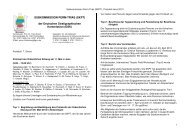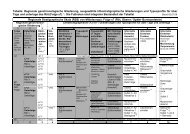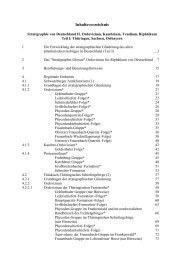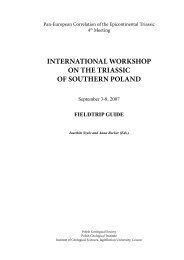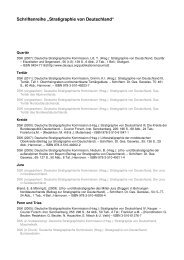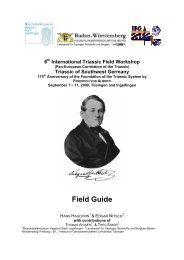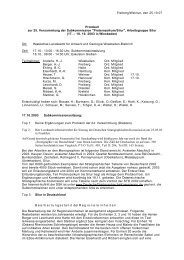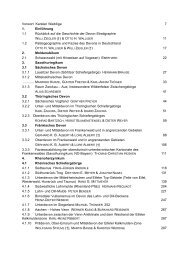International Field Workshop on 'The Triassic of eastern France'
International Field Workshop on 'The Triassic of eastern France'
International Field Workshop on 'The Triassic of eastern France'
Create successful ePaper yourself
Turn your PDF publications into a flip-book with our unique Google optimized e-Paper software.
Stop 3.8 - Grosbliederstr<strong>of</strong>f (N61 road cutting): Hardegsen unc<strong>on</strong>formity (between<br />
Middle and Upper Buntsandstein)<br />
The Hardegsen unc<strong>on</strong>formity (Fig. III.2, III.3, III.4) is well marked in this outcrop (Fig. 37). The ‘Grès<br />
vosgien’ Formati<strong>on</strong> is truncated by channel like structures filled with c<strong>on</strong>glomerate facies (Fig. 39). This<br />
c<strong>on</strong>glomerate facies is attributed to the ‘C<strong>on</strong>glomérat de Bitche’, very different <strong>of</strong> the ‘C<strong>on</strong>glomérat<br />
principal’; it c<strong>on</strong>tains ‘C<strong>on</strong>glomérat principal’ pebbles mixed with pedogenic carb<strong>on</strong>ate and carnelian<br />
pebbles reworked from the ‘Z<strong>on</strong>e Limite Violette’. In some places this c<strong>on</strong>glomerate is completely lacking,<br />
and the ‘Couches intermédiaires’ Fm rests directly above the ‘Grès vosgien’ separated by the Hardegsen<br />
unc<strong>on</strong>formity. The two formati<strong>on</strong>s can be easily distinguished by the systematic presence <strong>of</strong> micas,<br />
numerous (and sometimes very coarse) feldspars and subangular quartz grains in the ‘Couches<br />
intermédiaires’ Fm.<br />
Figure 39: Outcrop <strong>of</strong> Grosbliederstr<strong>of</strong>f and detailed view <strong>of</strong> the channel like structures filled with c<strong>on</strong>glomerate<br />
facies which truncated the ‘Grès vosgien’ Formati<strong>on</strong><br />
Day 4 — Friday, 06.10.2006<br />
Stop 4.1 - Weiskirch: Lower Muschelkalk (‘Grès coquillier’ Fm, with ball-and-pillow<br />
structures)<br />
A particular structure is observed in the ‘Grès coquillier’ Fm (Table 1): ball and pillow (Figs. 40, 41).<br />
This is a particular load-cast structure, which occurs <strong>on</strong> the lower surfaces <strong>of</strong> beds <strong>of</strong> sandst<strong>on</strong>es interbedded<br />
with mudst<strong>on</strong>e, and forms pseud<strong>on</strong>odules in the sandst<strong>on</strong>e facies. In some case, there is no sign <strong>of</strong> an<br />
overlying sandst<strong>on</strong>e and the isolated pseud<strong>on</strong>odules ‘float’ in the mudst<strong>on</strong>es (Collis<strong>on</strong> and Thoms<strong>on</strong>, 1993).<br />
66



